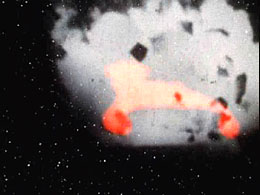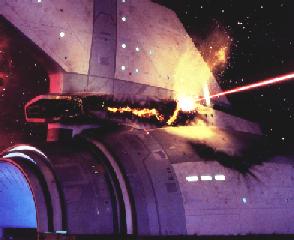I believe the ineffectiveness of phasers was due to what the Planet Killer was made up of, so it wouldn't really matter what strength the phasers were if the target is immune to it.
Learn how to read, my dear sir. He specifically mention the Planet Killer's maw... it's "mouth", to the plebians in the audience. He did NOT mean its "hull". The Planet Killer was destroyed by an explosion of only a few dozen megatons in its maw... if phasers were capable of anywhere NEAR that level of firepower, they would have been used.
Also speaking of that episode, I vaguely remember the E-Prime being fired upon by the thing, evidently the same weapon that can destroy planets.
It's never said that it can "destoy" planets. Only that it carves up planets and eats them. A timeframe is NEVER specified, and as such, firepower cannot be derived.
1: I don't see why you're getting so upset and calling me names. Are you a child or something?
He's getting upset because you're not paying very good attention to his posts. I do not mean to be insulting, but I have to ask... is English not your native language? You're missing a lot of information in someone else's posts, indicating that you're either not fully reading someone's post before responding, or you just don't fully understand it. If it's the former, I would suggest that you read someone's post more carefully... it's considered quite rude to just gloss over what they say.
2: You're not making sense. In the episode in question, with the F-104, the Enterprise was already severely damaged and had a severe power shortage problem. In the episode with the 1% phasers, the Enterprise wasn't heavily damaged, it was perfectly fine.
In the "travel back in time" episode, the hull is still perfectly sound. This provides us with a rough upper limit at what their unprotected hulls should be able to withstand. In the "Ultimate Computer" episode, the fact that they dial down to 1% phasers indicates that anything higher could pose a threat to the other ship. Remember, this is a war game... they want to make
absolutely sure that they don't harm the other ship, EVEN IF, by freak accident, the phaser shot manages to strike hull. Ergo, they dialed down the phasers to a level that would be safe even if it struck bare hull.
From there, we can extrapolate a rough parity between the two episodes. Now, GAT does make one mistake, in my opinion, of assuming that phaser power dials down linearly... however, that estimate can't be off by more than an order of magnitude, in my opinion.
I wasn't aware that the Enterprise is an aircraft.
No offense, my dear sir, but that's a stupid response. Even if the Enterprise is not technically an "aircraft", it was in a position where it was BEHAVING as one. The point he was making was that you can only use bombs on GROUND targets, and the Enterprise was most certainly not on the ground.
Free-fall bombs are routinely used on naval ships of roughly the same size as the Enterprise.
Which are on the surface, NOT up in the air.
But you're ignoring the fact that THE F-104 DID NOT CARRY THE GENIE, AND A SIDEWINDER IS NOT A NUCLEAR WEAPON .
No, he is not. Those facts are irrelevent. What IS relevent is that Spock
believed that the F-104
might carry a nuclear weapon, and that this weapon posed a significant risk to the ship.
Think of it this way... if you believed that a letter you received in the mail contained anthrax, how would you react to it?
Remember, it's entirely Spock's belief that's the crux of the argument, here. He believed that the F-104 posed a risk, even if we, as the audience, know otherwise. He believed that it carried nuclear weapons, even if it did not. He believed that these nuclear weapons posed a threat, even if they didn't exist.
The important thing is that Spock is saying that a low-kiloton nuke posed a significant risk to the Enterprise.
